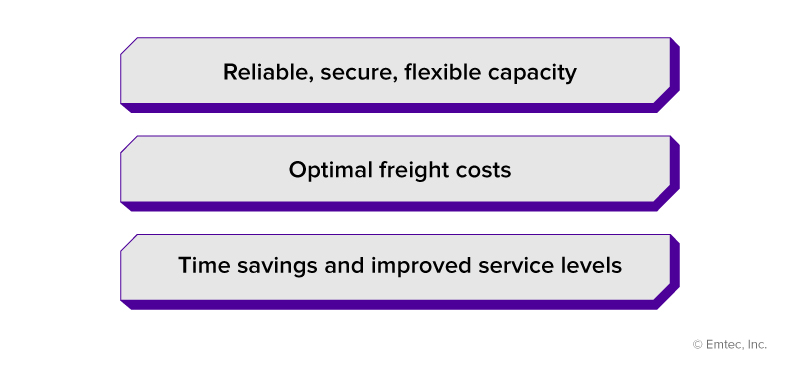Dynamic Freight Pricing is becoming quite prevalent in the ‘rapidly digitalizing’ logistics industry, helping shippers and 3PLs keep their finger on the pulse of the freight market. There is a significant volume of shipment data captured daily from multiple carrier networks across geographies. This data – combined with dynamic market data – can be better utilized to determine freight rates in real time by mapping freight characteristics with available carrier capacity. Dynamic Freight Pricing integrated into existing enterprise systems can help carriers adjust rates for lane imbalances and optimize truck utilization across different lanes. The dynamic pricing model recalibrates with better pricing in lanes short on loads, allowing shippers and 3PLs to benefit from soft spots or balanced pricing when carriers launch their services in new lanes.
In our previous blog, we spoke at length about Dynamic Freight Pricing (DFP) and highlighted the various benefits of incorporating dynamic pricing models for shippers, 3PLs, and carriers. In this blog, we get into the technical specifications of integrating DFP into the tech stack – more specifically the Transportation Management System (TMS).
Top Reasons Shippers Should Consider Integrating Dynamic Pricing into Their TMS
Shippers need a network of reliable carriers at competitive market rates to manage freight. DFP–TMS integrations provide shippers with a better understanding of lane performance and how different parameters of truckload freight may impact overall transportation costs. Some of the top reasons why shippers should integrate dynamic pricing models into their TMS are:

- Reliable, secure, flexible capacity: Real-time visibility into carrier quotes based on prevalent market rates for different lanes allows shippers and 3PLs to procure secure, flexible capacity for quickly moving spot loads. DFP factors in fluctuating market conditions, providing accurate and reliable pricing data that considers aspects such as weather, fuel prices, seasonality, and carrier/trucker availability.
- Optimal freight costs: Dynamic pricing models help shippers compare carrier quotes with prevalent lane rates and determine if the rates are competitive for specific lanes and loads. This maximizes monetary savings over time, enables optimal selection of freight modes, and eliminates inefficiencies.
- Time savings and improved service levels: Integrating DFP into the TMS helps shippers and 3PLs procure additional trucking capacity quickly, saving time spent waiting for load pickup confirmations from secondary carriers. Shippers can avoid delays in service, high instances of tender rejections, and expensive deliveries of last-minute loads.
The Potential Ramifications of Not Leveraging Dynamic Pricing
Logistics organizations using static pricing in an inherently dynamic market could find themselves paying more in transportation costs. With these costs already making up a large portion of freight budgets, it could lead to lower profit margins. Shippers may also struggle to source adequate capacity. When capacity is scarce, it becomes difficult to maintain optimal levels of service. A smaller, less varied capacity network often means paying higher prices for loads. Without access to a broad network of carriers from whom they can gather quotes, shippers and 3PLs are often willing to jump at the first sign a carrier can take the load, regardless of the rate that carrier is charging.
Dynamic Freight Pricing Technology Integrations: What Are the Options?
Once shippers have decided that they need to make the jump to dynamic pricing, there are a couple of ways to go about implementing it. Both options come with unique pros and cons, so it’s about finding the option that fits your needs the best.
Developing a dynamic pricing system from scratch: When you build your own application from scratch, you get the benefit of a program that is engineered and designed with your business needs in mind. A system built to your exact freight management specifications can slip right into existing workflows, avoiding the need for end users to significantly change their processes, and reducing the potential challenges of adopting the new system.
There is some risk involved when you’re building in-house software, but an experienced development team can go a long way towards allaying those risks and ensuring the project is successful. They can offer advice on the best hosting option, platform, and architecture to fit your needs. Building an application from scratch often takes more time than implementing a third-party solution, and it will need to be updated as market dynamics change and technologies in the tech stack evolve. For those reasons, having your own system can require more tech support than buying one, as maintenance and alterations must be handled in-house or contracted out to an IT company.
Utilizing a third-party dynamic freight pricing application: There are several pre-built dynamic freight pricing options available in the market today, and there’s a solution that is, at the very least, serviceable for all types and structures of logistics companies. There are several benefits in buying a pre-built system and integrating it into your existing tech stack––such as predictable cost of ownership, less maintenance, and an expedited go live. Many third-party aggregators are designed to plug directly into popular TMS programs, making for a quick and easy implementation.
Conversely, third-party systems may require more time and labor-intensive integrations. As not every program is designed to plug and play nicely together, and new systems may not use the same type of integrations as the existing tech stack, integrating can still require specialized tech support. Integration issues can sometimes create functionality issues as well. For example, some TMS systems don’t support certain functions of third-party applications unless the latest version of the TMS is being used. For many companies, updating to the latest version can be cost-prohibitive and come with a steep learning curve. Whether you choose to buy or build your dynamic freight pricing platform, integrating it into your existing tech stack is crucial to ensure the system has access to the data it needs (market data and historical pricing data) to provide accurate pricing.
Several integrations are needed for a dynamic freight pricing program to function at its peak and provide up-to-date pricing information. The program will likely need to be connected to a market data platform to provide real-time market pricing; a TMS or ERP platform (depending on which technology is used to manage transportation operations); plus, any applications that store, record, or analyze data and other relevant programs in the tech stack. For example, dynamic pricing could be tied into a proprietary capacity management system to help both programs collect better data.
Integrating Dynamic Freight Pricing into the TMS
It’s common today that both shippers and 3PLs utilize a TMS program to manage part or all of their transportation operations. By integrating dynamic freight pricing into the TMS, shippers gain access to real-time pricing and capacity information that can be useful in load tendering, load booking, and route guidance. Both TMS and dynamic freight pricing systems can then be connected to third-party syndication services for simple posting to load boards with competitive, market-sensitive costs. Depending on the other systems in the tech stack, both API and EDI integrations may be needed to create seamless connections between all programs. These types of integrations facilitate fast, easy connections between programs to provide 360° visibility across multiple platforms. Dynamic pricing integrations based on API connectivity are fast gaining adoption, as API integrations enable logistics companies to reduce costs by processing multiple customer queries with speed and efficiency.
Logistics operations are more streamlined when critical integrations are baked into core transportation management systems. DFP–TMS integrations provide quick, instant, real-time access to carrier quotes on specific lanes and specific load types. These rates are derived automatically based on numerous market data points including fuel prices, weather conditions, and driver/truck availability. Dynamic pricing integrations into the TMS offer maximum lane pricing visibility and flexible trucking capacity for faster, guaranteed coverage. With real-time pricing, shippers and 3PLs can award contracts based on not only the right rates but after factoring in critical KPIs such as on-time delivery scores, EDI and tracking compliance, etc.
Conclusion
It’s a no-brainer that shippers, 3PLs, and carriers alike can benefit from adopting a well-integrated dynamic freight pricing program. This type of technology will likely become the gold standard as the transportation and logistics industry continues to evolve with the employment of new and emerging technologies.
Are you at the critical decision point of deciding whether to build a dynamic pricing engine from scratch or purchase a readymade third-party solution? If you are stuck in the build vs. buy conundrum, the logistics technology experts at Bridgenext can guide you. Contact us to learn more.




